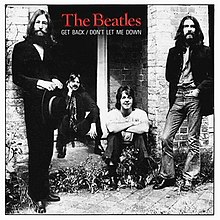Loading AI tools
1969 single by the Beatles with Billy Preston From Wikipedia, the free encyclopedia
"Don't Let Me Down" is a song by the English rock band the Beatles, recorded in 1969 during the Let It Be sessions. It was written by John Lennon and credited to the Lennon–McCartney songwriting partnership. The band recorded the song with keyboardist Billy Preston; the single release with "Get Back" was credited to "the Beatles with Billy Preston". Originally released as a B-side, producer Phil Spector excluded the song from Let It Be. The song's first appearance on an album was on the 1970 collection Hey Jude.
| "Don't Let Me Down" | ||||
|---|---|---|---|---|
 Picture sleeve for 1989 UK reissue | ||||
| Single by the Beatles with Billy Preston | ||||
| A-side | "Get Back" | |||
| Released | 1969 | |||
| Recorded | 28 January 1969, February 1969 | |||
| Studio | Apple, London | |||
| Genre | ||||
| Length | 3:35 | |||
| Label | Apple | |||
| Songwriter(s) | Lennon–McCartney | |||
| Producer(s) | ||||
| The Beatles singles chronology | ||||
| ||||
| Billy Preston singles chronology | ||||
| ||||
| Audio sample | ||||
Don't Let Me Down | ||||
| Music video | ||||
| "Don't Let Me Down" on YouTube | ||||
Written by John Lennon as an anguished love song to Yoko Ono,[5] it was interpreted by Paul McCartney as a "genuine plea", with Lennon saying to Ono, "I'm really stepping out of line on this one. I'm really just letting my vulnerability be seen, so you must not let me down."[6]
The song is in the key of E major and is in 4
4 time during the verse, chorus and bridge, but changes to 5
4 in the pick-up to the verse.[7] It grew (like "Sun King") from the F♯m7–E changes from Fleetwood Mac's "Albatross" with McCartney arranging instrumental and vocal parts and George Harrison adding a descending two-part lead guitar accompaniment to the verse and a countermelody in the bridge.[8] Alan W. Pollack states that "the counterpoint melody played in octaves during the Alternate Verse by the bass and lead guitars is one of the more novel, unusual instrumental touches you'll find anywhere in the Beatles catalogue."[9]
Multiple versions of "Don't Let Me Down" were recorded by the Beatles during the Get Back (Let It Be) recording sessions. The version recorded on 28 January 1969, with vocal overdubs in early February, was released as a B-side to the single "Get Back", recorded the same day.[10] "Get Back" reached number one and "Don't Let Me Down" reached number 35 on the US Billboard Hot 100.[11] When the "Get Back" project was revisited, Phil Spector dropped "Don't Let Me Down" from the Let It Be (1970) album.[12]
The Beatles performed "Don't Let Me Down" twice during their rooftop concert of 30 January 1969, and the first performance was included in the Let It Be (1970) film, directed by Michael Lindsay-Hogg.[13][14] In November 2003, a composite edit of the two rooftop versions was released on Let It Be... Naked.[15][14] Both versions were seen in the 2022 film The Beatles: Get Back - The Rooftop Concert and are featured on the live album.
The B-side version of the song was included on the Beatles' compilations Hey Jude, 1967–1970, Past Masters Volume 2 and Mono Masters. The same recording also appears on the soundtrack to the 1988 documentary, Imagine: John Lennon.
In 2021 numerous versions of the song was included on Let It Be: Special Edition, including the Get Back LP version and a new mix of the original B-side version with an added dialogue introduction.
Richie Unterberger of AllMusic called it "one of the Beatles' most powerful love songs",[16] Stephen Thomas Erlewine of AllMusic described the song as "heart-wrenching soul"[3] and Roy Carr and Tony Tyler called it "a superb sobber from misery-expert J. W. O. Lennon, MBE. And still one of the most highly underrated Beatle underbellies."[17] Author Ian MacDonald praised "Don't Let Me Down" and declared that "this track vies with 'Come Together' for consideration as the best of Lennon's late-style Beatles records".[18] "Don't Let Me Down" is the most viewed video on the Beatles' YouTube channel, with over 400 million views.
American alternative rock band Wilco covered the song along with "Dig a Pony" in 2021. The covers were released exclusively on Amazon Music for a promotional campaign marking the release of the Let It Be: Special Edition reissue.[19]
No official producer's credit was included for the single release owing to "the confused roles of George Martin and Glyn Johns".[21] However the 1967–1970 compilation liner notes credited Martin as the song's producer.
| Chart (1969) | Peak position |
|---|---|
| US Billboard Hot 100[22] | 35 |
Seamless Wikipedia browsing. On steroids.
Every time you click a link to Wikipedia, Wiktionary or Wikiquote in your browser's search results, it will show the modern Wikiwand interface.
Wikiwand extension is a five stars, simple, with minimum permission required to keep your browsing private, safe and transparent.